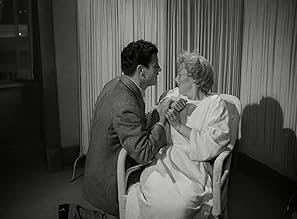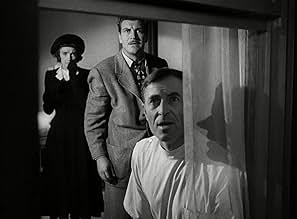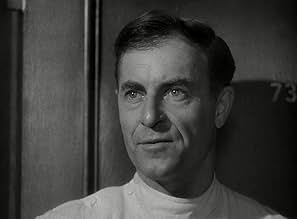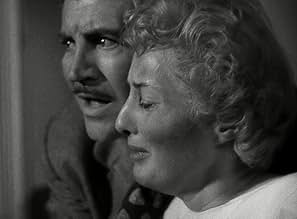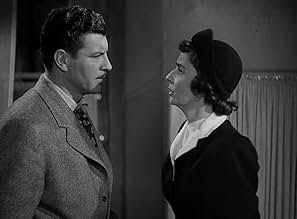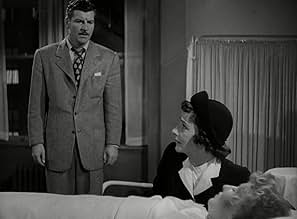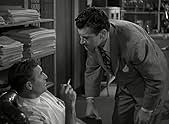Joan acompaña a su marido David a Las Vegas, donde él debe escribir un artículo. Mientras él trabaja en el reportaje, ella mata el tiempo jugando en los casinos; pero lo que empieza como un ... Leer todoJoan acompaña a su marido David a Las Vegas, donde él debe escribir un artículo. Mientras él trabaja en el reportaje, ella mata el tiempo jugando en los casinos; pero lo que empieza como un pasatiempo se acaba convirtiendo en una adicción.Joan acompaña a su marido David a Las Vegas, donde él debe escribir un artículo. Mientras él trabaja en el reportaje, ella mata el tiempo jugando en los casinos; pero lo que empieza como un pasatiempo se acaba convirtiendo en una adicción.
- Dirección
- Guión
- Reparto principal
- Premios
- 3 premios en total
- Chuck
- (as Phil Van Zandt)
- Bellboy
- (as Anthony Curtis)
- Jack Harrison - Hotel Clerk
- (as Peter Lewis)
Reseñas destacadas
Despite the potential, 'The Lady Gambles' doesn't completely live up to it. It starts off very well and had all the makings of a great film, but the second half or so is less good or compelling with the very late stages feeling like a different film. 'The Lady Gambles' is definitely worth the look and Stanwyck, as expected, makes things a lot better than it had a right to be, but this was an interesting and heavily flawed affair as an overall whole.
Stanwyck is the best thing about 'The Lady Gambles', she did steely and vulnerable better than a lot of actresses at that time and to this day long after her death she remains one of the best ever at those. Both of those can be seen to intense and moving effect and she really does give it everything she's got. The other acting standout is the genuinely intimidating Stephen McNally, goodness does that man have a menacing presence here and the drama does really come alive with him. Enough of the direction is competent.
It is a well shot film and Frank Skinner's music avoids being overly-melodramatic and is not sugary. 'The Lady Gambles' starts off very well with an intriguing and suitably tense first half, that has edge and one does care about how things are going to go.
Which is why it was a shame that to me 'The Lady Gambles' wasn't as compelling later on, where the film became rather predictable and lacked the tension it should have had. Where the dialogue can be on the soapy side and it gets very melodramatic.
As does Robert Preston's performance, which does get too over the top, and his character is too naive that one wants to give him a shake and scream "wake up" in his face. The ending is very corny and far too soft for the subject, like the film had run out of ideas or something.
Concluding, worth seeing for Stanwyck but could have been more. 6/10
The opening scene is incredibly engaging and shocking. Barbara walks out into an alley, then gets beaten by a group of thugs and left for dead. Next, Robert Preston runs into a hospital, demanding to know how his wife is. He tells the doctor in charge, and the audience, the story of how she ended up this way. While the storytelling method is a little cheesy, Barbara's performance more than makes up for it. She's fantastic, and completely in her element as she's given the opportunity to show off every human emotion throughout the film. She's innocently curious as she tags along on her husband's business trip to Las Vegas, and her slow descent into addiction is riveting. She's deceitful, ashamed, devious, desperate, and completely unable to stop. Her eyes light up when she wins, and she feels like her life's over when she loses. If you've never seen a Barbara Stanwyck movie, this is a great place to start.
Stanwyck stars as the wife of newspaper journalist Robert Preston. They are in Las Vegas while he covers a story. Stanwyck decides to try to do an article herself on the gambling scene but her somewhat indiscreet camera work catches the eye of casino manager Stephen McNally who decides to let her play with valueless chips so she can be at the tables for her research. Trouble is Stanwyck finds she likes the tables a little too much and when McNally decides to put a plug in the playing for nothing, she dives into Preston's expense account and loses it all in a night. McNally, clearly attracted to Stanwyck from first sight, gives her $50 to play with out of pity after she has even hawked her expensive Swiss camera and being the good player she is Stanwyck actually wins her money back. But the lure of the tables is too strong and she keeps going back. And back. And losing. Ultimately destroying her marriage, she eventually joins forces with McNally in some of his questionably legal activities and later hits earthier lows in pursuit of lady luck where one seedy guy after another tells her to "kiss 'em for me baby" as she rolls the dice.
The movie is told in flashback as Stanwyck is hospitalized having been beat up by gamblers when she is caught dealing in a back alley crap game with loaded dice. Estranged husband Preston rushes to her side and tells the doctor the whole sad story.
The usually dependable Preston is one of the weakest links in the film; his character is alternately a milquetoast and a control freak but is at all times presented as Stanwyck's prince charming. Preston's performance is no help either, his rather theatrical delivery seems inappropriate for this attempt at "slice of life" drama; worse, in an amazingly unwise decision he speaks to the doctor in anguished troubled tones and then his narration over the past scenes is spoken with enthusiasm and dramatic flair! Stephen McNally fares much better as the intimidating Vegas big shot, his scenes with Stanwyck have considerable bite and are the film's highlight.
The worst thing about the film is the jaw-dropping pop psychology that attempts to explain away Stanwyck's gambling. It's because of her possessive older sister Edith Barrett!!! With her mother dying during childbirth, Stanwyck was "raised" by older (eight years, although Barrett was actually just six months older than Stanwyck) sister who has never let Barbara forget the sacrifices in her personal life she has made for her. Hero Preston seems frankly as controlling but since he is her husband, presumably that's OK with the screenwriters. The sister-is-the-root theory is interesting considering (A) Preston is hostile to the sister and her relationship with Barbara long before the gambling starts, (B) the gambling doesn't even start until Stanwyck is clearly into her thirties and (C) the sister is no where around to cause anxiety when most of the gambling binges occur!! But then what can you expect of reason from a film where a doctor attempts reverse psychology, encouraging a patient on a building ledge to jump!!
Barbara Stanwyck is always worth watching, her progression from dabbler to desperate is quite credible but even her solid work here can't save a movie that plays like a 1940's version of a 1970's half-baked "social issue" TV movie. Two stars going in opposite directions are also in the cast: newcomer Tony Curtis has an early bit part as a bellhop and 30's leading man Leif Erickson can be seen in a small role as one of McNally's questionable cohorts. Is this picture worth checking out? Well, it's your gamble.
First you start with a flashback by Preston's character that isn't quite a flashback, because we are more interested in who this man is and what the circumstances of his plight are, than the past per se. Virtually all Hollywood flashbacks seem to involve some grand police confession or some need to explain the confessor (such as "D.O.A.")but the flashback here seems to add to the convolutedness of the characters, and the surrealism of the situation. Does Preston really understand his wife? If so when? The flashback reminds us that there is more to explain than the "what",but also the "why" which neither Preston nor the audience yet understand (gambling is a disease, but the matter of guilt and personal responsibility for misdeeds remain open).
More convolutedness in the photography. Carefully cropped chest-up body shots, with swirling camera movements amid authentic but claustrophobic interiors. Remember, only Max Ophuls was supposed to have done this sort of thing at the time! I remember "Leaving Las Vegas" attempted the same themes in slightly different ways (misery and anomie in a spectacular setting) but that was a miserable film.
Finally you have a not so sweet resolution to depict insanity, but in a much subtler way than "The Snake Pit" and other entries in the growing body of 'social consciousness' films. Stanwyck was a tough-soft actress, and the scenes where she rolls before a throng a gamblers rarely came tougher in her films. A work to just watch.
The film is interesting to watch for the location settings. I actually bought it specifically for the Las Vegas setting as it is where I got married earlier this year and I wanted to make a comparison with 1949. The story was incidental. As it turns out, the story is OK if predictable. Stanwyck carries the film with good support from gangster Stephen McNally (Mr Corrigan). Robert Preston changes his tune during the course of the film as he swings from rejecting her to accepting her while the role of Stanwyck's sister Edith Barrett (Ruth) is pretty annoying and some sentimental pop psychology is dragged into the proceedings.
I'm sure that the inspiration behind the Las Vegas section of the film was Bugsy Siegel and his Flamingo Hotel which paved the way for the notoriety of the Strip. The main body of the film is set in the Pelican Hotel (a bit similar?) and McNally has an interest in a horse racing scam just as Bugsy did.
The film ends in a disappointingly corny way after a funny moment when John Hoyt shows us what to say to someone when they are about to jump off a window ledge. I dare you to try it some day! As for the film's climax, we have to hopefully imagine that everything will go downhill again once they return to Vegas and hit the casinos.
¿Sabías que...?
- CuriosidadesThe scene where Corrigan (Steven McNally) tells the girls "No-one uses my first name....because it's Horace" could well have been an in-joke as Stephen McNally's birth name was Horace Vincent McNally.
- PifiasReflected in the bus window that Joan is on.
- Citas
Joan Phillips Boothe: May I come in?
Barky: Ask a foolish question, and you get a foolish answer.
Selecciones populares
- How long is The Lady Gambles?Con tecnología de Alexa
Detalles
- Fecha de lanzamiento
- País de origen
- Idiomas
- Títulos en diferentes países
- The Lady Gambles
- Localizaciones del rodaje
- Hoover Dam, Arizona-Nevada Border, Estados Unidos(Second unit)
- Empresa productora
- Ver más compañías en los créditos en IMDbPro
- Duración1 hora 39 minutos
- Color
- Relación de aspecto
- 1.37 : 1
Contribuir a esta página


